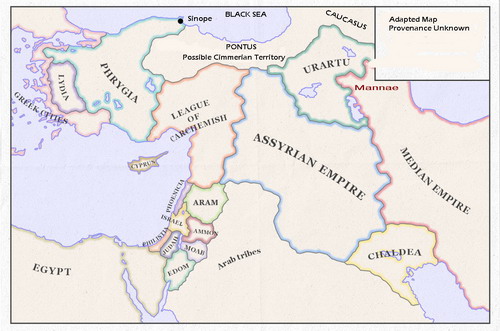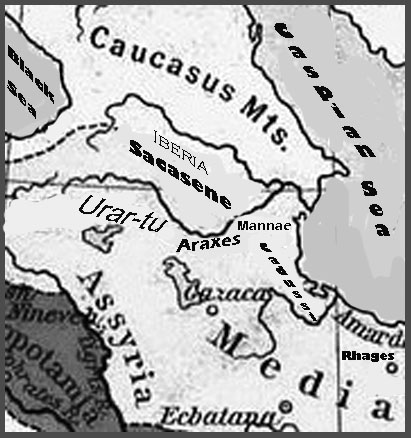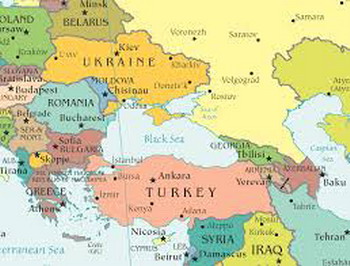Cimmerians from the Middle East? Summary and notes on an article by Vladimir Eiujj, (9 July, 2014, 11 Tammuz, 5774)
Source:
THE ARCHAEOLOGICAL EVIDENCES OF THE EARLY PERIOD OF MILITARY CONTACTS BETWEEN THE BLACK SEA NORTH LITTORAL AND THE ANCIENT EAST AND THE "CIMMERIAN PROBLEM"
by VLADIMIR ElUJJ
CuPAUAM.20, 1993, pp. 133-145
http://www.uam.es/otros/cupauam/pdf/Cupauam20/2006.pdf
================================================================
================================================================

Introduction by Yair Davidiy
The Northern Israelites were exiled by the Assyrians to northern areas of the Assyrian Empire.
2-Kings 17:
6 In the ninth year of Hoshea, the king of Assyria captured Samaria; he carried the Israelites away to Assyria. He placed them in Halah, on the Habor, the river of Gozan, and in the cities of the Medes.
The Cities of the Medes was in the region of Media. It adjoined Mannae.
The Aramaic Translation to Amos (4:3) says that the Israelites were exiled to Beyond the Mountains of Mannae. This region involved the Kingdoms of both Assyria and Urartu. Israelite Exiles were in both areas as reflected in the Histories of Armenia.
In these areas the Israelites federated with other peoples known generically as the Sons of Gomer. They included the Cimmerians and Scythians. Other scholars reached similar conclusions before us. They usually equated all of the Cimmerians and company with the Lost Ten Tribes. We however only make such an equation for a portion of them.
Two separate possible scenarios concerning the Cimmerians exist.
Which of the two is the more correct, does not overduly affect our understanding as to what happened.
(1) Did the Cimmerians come mainly from the north, go south, and then move back northwards?
Or:
(2) Did they originate in the Middle East and then later move northward?
[As far as we are concerned the linkage with Israel is the main point. This occurred when the Israelites were in Exile. The combined Israelite-Cimmerian entity was naturally a different body from the original Cimmerians, wherever they came from. Nevertthless a look at ther discussion concerning the Cimmerians helps us understand the historical background.]
Classical, especially Roman, sources support the possibility that the Cimmerians came from the north and were in fact only a minor offshoot from their main body that remained in the north. That is how most authorities also describe the situation. It is also the view we incline to.
Archaeological findings, as distinct from archaeologists, are more supportive of the second option. The Cimmerians as we meet them in Assyrian writings and archaeological findings do not seem to have had immediate northern origins.
Even though we may not consider the Cimmerians to have mainly come from the Middle East the fact that such a possibility is considered to have existed is important. It highlights the feasibility of Israelites have comprised a good portion of those Cimmerians who really were in the Middle East and later moved northward. If non-Israelite Cimmerians could move northwards then why could Israelite exiles who had been in the same region not do the same?
Conventional mainstream understanding inclines to the view that the Cimmerians and Scythians originated north of the Caucasus somewhere in Eurasia, came south, and later moved north again. The Scythians emerged from the Cimmerians. [The Cimmerians and Scythians are at times treated as effectually the same people and elsewhere as separate].
Vladimir Eiujj (THE ARCHAEOLOGICAL EVIDENCES OF THE EARLY PERIOD OF MILITARY CONTACTS BETWEEN THE BLACK SEA NORTH LITTORAL AND THE ANCIENT EAST AND THE "CIMMERIAN PROBLEM", by Vladimir Eiujj; CuPAUAM.20, 1993, pp. 133-145) discusses the possibility (based on archaeological evidence) that the Cimmerians originated south of the Caucasus within the confines of the Urartian and Assyrian domains in the later 700s-600s BCE.
The paper by Vladimir Eiujj is somewhat technical. We found it a little difficult to understand at first. Vladimir assumes prior familiarity with archaeological findings and different schools of thought that even a professional might not be up to date with. Nevertheless the information is important so we have taken the liberty of simplifying the text for the sake of noting what we consider to be the more salient points.
This article may in places be taken almost VERBATIM from Vladimir Eiujj but elsewhere it relies on our own paraphrasing and/or personal opinion.
Those who really need to know which is which should read the original by V. Eiujj.

To remind you of the background,
The Cimmerians were first recalled as at war with Urartu (Ararat). They were then in the region of Mannae west of Media and north of Assyria. Some (e.g. Kristensen) consider the Cimmerians to have been auxiliaries in the Assyrian forces. At all events there were Cimmerians and a Cimmerian regiment in the Assyrian army. They specialized in equestrian matters, chariots and cavalry. The Scythians emerged from the Cimmerians. References to Cimmerians in some contexts are considered to actually mean Scythians. One can say that the Cimmerians split into two different sections in which one of them was dominated more by Scythians than the other. The two parts fought against each other. The more Cimmerian section was driven out and went westward into Europe where it helped form Celtic Civilization. The other more Scythian body remained in the area longer. After serving the Assyrians and being allied with them they joined the opposing side and helped the Medes and Babylonians destroy the Assyrian Empire. The Medes betrayed them and massacred their leadership. After that they were driven in stages to the north. The Eurasian area north of the Caucasus is henceforth known to historians as Scythia. We trace the Angles and Saxons and related nations in Scandinavia, etc, to the Scythians.
================================================================
================================================================

The Argument of Vladimir Eiujj
Since the last century there have been two traditions concerning the origin of the Cimmerians as shown in historical literature.
The first tradition, which follows the information provided by Herodotus and other Greek authors, proposed that the Cimmerians inhabited the area north of the Black Sea (i.e. North Pontic) before the invasion of the Scythians, whom they saw as a separate people. In addition to the legend of the Cimmerians, Herodotus pointed out the existence of contemporary "Cimmerian" toponyms in this region: "The Cimmerian Bosphorus", "Cimmerian banks", region of "Cimmeria" (Her.IV. 12.).
In the archaeological literature the concept of a North Pontic origin for the Cimmerians was most consistently presented in a monograph of Alexey Terenozhkin "The Cimmerians" (Terenozhkin, 1976). It is agreed that in the 700s-600s BCE period [or later] the North Pontic (i.e. north of the Black Sea and the Caucasus) region was taken over by the Scythians.
Terenozhkin ascribed all pre-Scythian finds of the Steppe and the Forest-Steppe of Ukraine complexes north of the Pontic to the Cimmerian culture. Terenozhkin also included in this culture two groups of nomadic population remains: the Chernogorovka and the Novocherkask ones. [It is amongst these nomadic groups that we find evidence of contacts with Assyria.]
On the other hand, in the last 20 years a series of studies rejected the North Pontic origin of the Cimmerians. The Italian scholar, Umberto Cozzoli, proposed that the traditions related by Herodotus and the "Cimmerians" toponyms should be dated to a later period (Cozzoli, 1968).
These ideas were developed in M. Salvini and A. Kristensen's works, published in the 1980s. The main argument of these authors was the absence in Assyrian inscriptions of direct mention of a coming from the North of the Cimmerians.
Later information from the time of Essarhaddon time placed the Cimmerians in the Country of Mannae, south of the Caucasus, and southeast of Urartu, and neighboring Media.
Salvini and Kristensen therefore searched for the fatherland of the Cimmerians, to the East and South-East of Urartu (Salvini, 1984; Kristensen, 1988).
Anna Kristensen believed that the Cimmerian tradition and the toponyms were brought to the Black Sea North Littoral by the Scythians who acted jointly with Cimmerians in the 600s BCE in Asia Minor (Turkey).
This point of view is close to the propositions of some Russian scholars such as Irina Kuklina (Kuklina, 1984, 56), Andrei Alekseev and Nataliia Kachalova (Alekseev, Kachalova, 1989), Sergei Tojtas'ev (1992). They refuted the existence of a Cimmerian culture in the North Pontic region.
Igor Diakonov supposed that "The Cimmerians" were not an ethnic group. He translated the Assyrian name given to the Cimmerians, "Gammiri", as any "mobile detachment of horsemen" (Diakonov, 1981).
As for archaeological findings considerable headways had been made in the 1970s.
A new early date (650-625 BCE) for the most important Scythian monuments, in the Kuban River area east of the Crimea, is supported by most scholars.
There is much archaeological evidence for contacts between the Northern Caucasus and North Pontic region with the Middle East and Trans-Caucasian area in pre-Scythian times.
Horse-bits of Middle East form together with details of harnesses similar to ones on Assyrian reliefs were found in the Forest-Steppe region of the Ukraine (Titenko,1954, 78, fig.1-3; 134 Kovpanenko, 1956, 174-179). Even earlier, some findings of fragmentary helmets of Assyrian-Urartian type were known from cemeteries in the North - Caucasus (Uvarova,
1909, 227; Kozcnkova, 1990, 79 - fig. 8, 20).
Such findings have since increased.
Almost all the artifacts we are writing about concern armament and horse harness equipment.
They can be divided into two groups:
(a) Within the first group we distinguished objects, that were directly adopted from Assyria and Urartu and concerned details of armor and helmets.
These artifacts had no prototypes in the local culture but had been known South of the Caucasus (e.g. in Assyrian and Urartu) a long time before.
The opinion of Chernenko ascribing Assyrian origin to the scale armor of the Scythians was confirmed by new evidence.
(b) Groups of objects created in the local culture, but doubtless, under Middle Eastem and Transcaucasian (Urartian) influence.
This meant "the import of ideas". One center of local production was the Kuban River region in the Northern Caucasus east of the Crimea.
The same kind of innovation was found in chariots and chariot harness.
In the Kuban River region remains of chariots were preserved in situ. A reconstruction of them showed that the arrangement of the team was similar to Assyrian ones, which are well-known from reliefs. These objects could have been created on a local basis after acquaintanceship with the Assyrian and the Urartian army, headed by charioteers.
We now know of more than 20 such complexes with details of chariots in the Northern Caucasus and the Ukranian Forest-Steppe region. Two complete examples of such chariot harness were also found in Central Europe.
As for the characteristic of contacts with The Middie East and Transcaucasia it is necessary to point out the following: If evidences of contact among the first group (helmets and armor) could have appeared as a result of import, the innovations of the second group clearly demonstrated the acquaintance of the local population with the army of Assyria and Urartu. Both groups of evidence could be the result of military campaigns.
All the complexes with evidences of contact may be chronologically divided into (1) upper, i.e. later and (2) earlier horizons.
(1) The upper [later in time] horizon was distinguished by the presence of Scythian arrowheads of a rhombic outline and particular cheek-pieces with three boles. These types had a Central Asiatic (Siberian) origin and were connected with the first wave of Scythians. These are now dated to ca. 650-625 BCE.
With these findings there was also found an image of the goddess Ishtar similar to that depicted on Assyrian reliefs from the time of Assurbanipal .
(2) In the early horizon the Scythian types of artifact are absent. This horizon can be dated by an Assyrian helmet and a horse fastening from Nosachevo [Udmert in Siberia] (Kovpanenko, 1966). The helmet from Kislovodsk (North Caucasus) belongs to type A-2 of Assyrian helmets, hammered from one piece of bronze, such as existed during the time of Tiglathpileser -iii (744-725 B.C.) and Sargon II (722-21 - 705 B.C). The horse fastenings from Nosachevo were dated to the time of Sargon II to Assurbanipal but are also present on reliefs of Tiglathpileser -iii  (744-727 B.C).
These findings may be connected with the first reports about the Cimmerians found in Assyrian narrative sources.
The Urartian King Rusa I campaigned in the country of Gamir. The time of this campaign has now been successfuliy dated by the scholars Anna Kristensen and Askold Ivanchik to the year 714 BCE (Kristensen, 1988, 42; Ivanchik, 1989, 6 ; 1990, 6-8). [Others date it about 7 years later].
Military contacts with the Cimmerian in that period were limited to the territory of Urartu and Western Assyria.
The upper [later] horizon of complexes with evidence of contacts corresponds chronologically to the Assyrian sources of the 600s BCE.
In Assarhaddon's appeals to the oracle of Shamash (680-670 B.C) it is mentioned that both Cimmerians and Scythians, were active together with Mannaens and Medes to the east of Assyria. Igor Diakonov and Askold Ivanchik supposed that in this case the name "Cimmerians" meant the Scythians or Sakae (Diakonov, 1981, 93; Ivanchik, 1989, 7). The Cimmerians Proper were then located by different sources in the regions of Cilicia and Capoddocia, i.e. to the south and west.
Sinope on the northeastern shores of the Black Sea in present-day Turkey with was described as a Cimmerian center.
Nearby Finds (from Amasis) dated to ca. 650 BCE ascribed to the Cimmerians had a mixed character.
There were elements connected with the East of Eurasia, with the North Caucaus; and with Transcaucasia to the south.
It may be that these complexes display a combination of two nomadic waves:
One came from the Asiatic Part of the Steppe and the other from the Northern Caucasus.
An Asiatic wave called "Scythians" may be reflected by the terms "Shkuza" and "Shkuda" in Assyrian sources.
The main argument of archaeologists against a North of the Black Sea origin for the Cimmerians is the absence in the South of the Caucasus of reported artifacts of the Novocherkassk period. In other words we find at an earlier date some evidence of Assyrian influence in the north BUT we do not find native North Caucasian type findings south of the Caucasus in Cimmerian times. It is therefore difficult to envisage the Cimmerians having come from the north.
VLADIMIR ElUJJ then says that contrary to general conceptions a few of the necessary findings have been reported. A couple of harnessing appurtenances appear to have come from the north and a few others, though locally produced, show northern influence. VLADIMIR ElUJJ admits that these finds are few in number.
Nevertheless he suggests that we leave the subject open.
In Summary,
Before the Cimmerians-Scythian Period there was some Assyrian contact with Nomads north of the Caucasus.
During the Cimmerians-Scythian Period south of the Caucasus we find Cimmerian-Scythian finds along with Assyrian ones north of the Caucasus.
Finds from the earlier period north of the Caucasus are not found south of it.
The Scythian finds also show some contact with groups to the east in Siberia.
Other studies (such as those of Michael Rostovtzeff and Maurits Van Loon) indicate that the Cimmerian-Scythian culture originated in the Middle East and developed there before moving northward.
This does not nullify the possibility that originally they had arrived from north of the Caucasus area.
See Also:
The Cimmerians, Scythians, and Israel
http://britam.org/CimmScyth.html
